Chapter 2: Biomolecular Mechanism of Mass Spectrometry Analysis
VerifiedAdded on 2022/08/12
|20
|5647
|23
Report
AI Summary
This report delves into the application of mass spectrometry (MS) in diagnostic chemistry, focusing on the principles of peptide fragmentation and bioconjugation. It begins with an overview of MS techniques such as MALDI-TOF MS and ESI MS, highlighting their roles in analyzing bio-analytes and ligand interactions. The report then explores the differences between bottom-up and top-down proteomics, detailing peptide fragmentation, side chain effects, and the influence of charge carriers. Furthermore, it introduces the concept and techniques of bioconjugates, emphasizing chemical linkages like C-N double bonds, and their importance in protein modification and drug conjugation. The report also discusses the chemical structure and mechanism of action of anthracyclines, and how MS is used for structural determination of peptide drug conjugates. Finally, it touches on the optimization of MALDI TOF-TOF and Orbitrap mass spectrometers for peptide fragmentation analysis, including CID, HCD, and ETD conditions. The report offers a comprehensive understanding of MS-based proteomics and its applications in various fields.
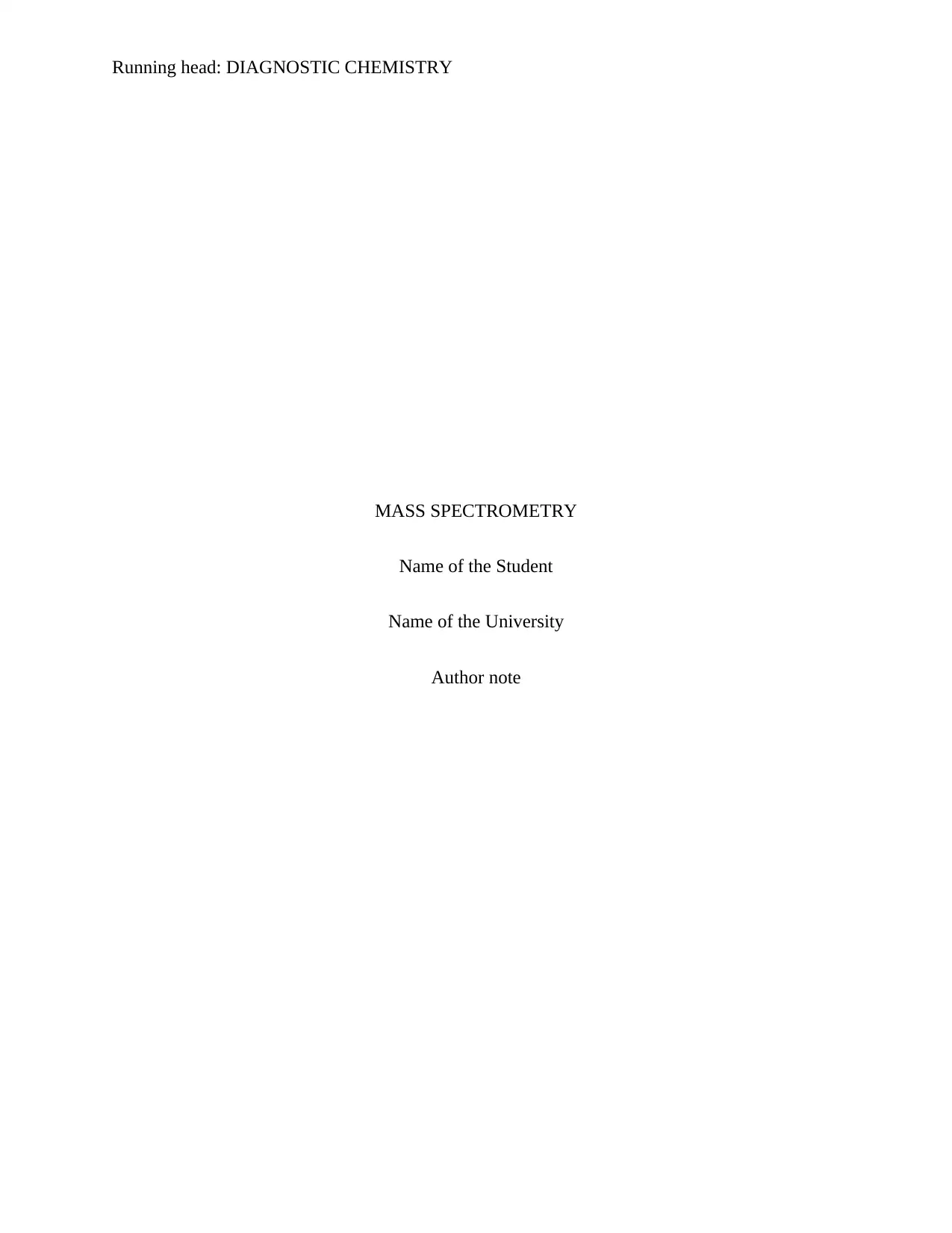
Running head: DIAGNOSTIC CHEMISTRY
MASS SPECTROMETRY
Name of the Student
Name of the University
Author note
MASS SPECTROMETRY
Name of the Student
Name of the University
Author note
Paraphrase This Document
Need a fresh take? Get an instant paraphrase of this document with our AI Paraphraser
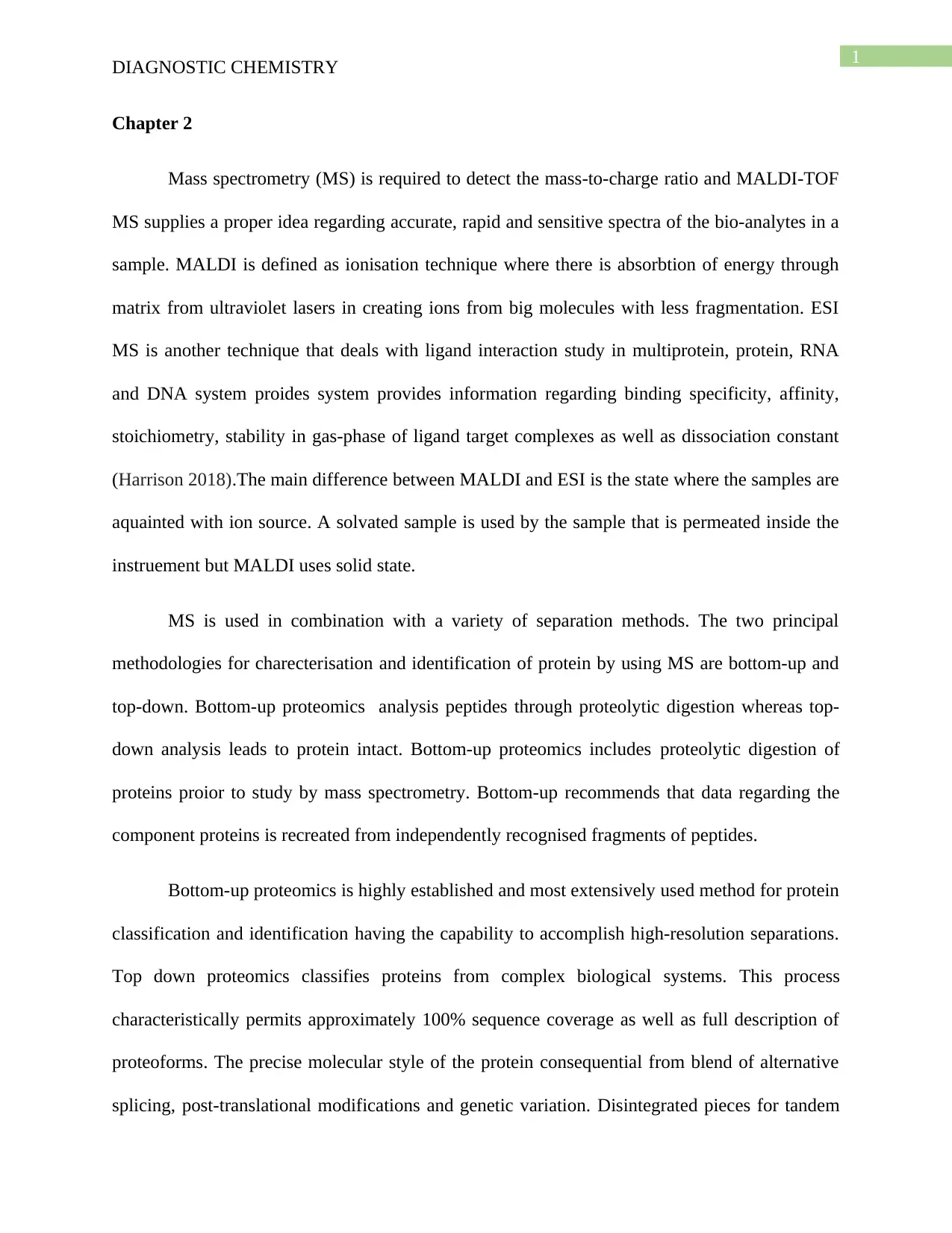
1
DIAGNOSTIC CHEMISTRY
Chapter 2
Mass spectrometry (MS) is required to detect the mass-to-charge ratio and MALDI-TOF
MS supplies a proper idea regarding accurate, rapid and sensitive spectra of the bio-analytes in a
sample. MALDI is defined as ionisation technique where there is absorbtion of energy through
matrix from ultraviolet lasers in creating ions from big molecules with less fragmentation. ESI
MS is another technique that deals with ligand interaction study in multiprotein, protein, RNA
and DNA system proides system provides information regarding binding specificity, affinity,
stoichiometry, stability in gas-phase of ligand target complexes as well as dissociation constant
(Harrison 2018).The main difference between MALDI and ESI is the state where the samples are
aquainted with ion source. A solvated sample is used by the sample that is permeated inside the
instruement but MALDI uses solid state.
MS is used in combination with a variety of separation methods. The two principal
methodologies for charecterisation and identification of protein by using MS are bottom-up and
top-down. Bottom-up proteomics analysis peptides through proteolytic digestion whereas top-
down analysis leads to protein intact. Bottom-up proteomics includes proteolytic digestion of
proteins proior to study by mass spectrometry. Bottom-up recommends that data regarding the
component proteins is recreated from independently recognised fragments of peptides.
Bottom-up proteomics is highly established and most extensively used method for protein
classification and identification having the capability to accomplish high-resolution separations.
Top down proteomics classifies proteins from complex biological systems. This process
characteristically permits approximately 100% sequence coverage as well as full description of
proteoforms. The precise molecular style of the protein consequential from blend of alternative
splicing, post-translational modifications and genetic variation. Disintegrated pieces for tandem
DIAGNOSTIC CHEMISTRY
Chapter 2
Mass spectrometry (MS) is required to detect the mass-to-charge ratio and MALDI-TOF
MS supplies a proper idea regarding accurate, rapid and sensitive spectra of the bio-analytes in a
sample. MALDI is defined as ionisation technique where there is absorbtion of energy through
matrix from ultraviolet lasers in creating ions from big molecules with less fragmentation. ESI
MS is another technique that deals with ligand interaction study in multiprotein, protein, RNA
and DNA system proides system provides information regarding binding specificity, affinity,
stoichiometry, stability in gas-phase of ligand target complexes as well as dissociation constant
(Harrison 2018).The main difference between MALDI and ESI is the state where the samples are
aquainted with ion source. A solvated sample is used by the sample that is permeated inside the
instruement but MALDI uses solid state.
MS is used in combination with a variety of separation methods. The two principal
methodologies for charecterisation and identification of protein by using MS are bottom-up and
top-down. Bottom-up proteomics analysis peptides through proteolytic digestion whereas top-
down analysis leads to protein intact. Bottom-up proteomics includes proteolytic digestion of
proteins proior to study by mass spectrometry. Bottom-up recommends that data regarding the
component proteins is recreated from independently recognised fragments of peptides.
Bottom-up proteomics is highly established and most extensively used method for protein
classification and identification having the capability to accomplish high-resolution separations.
Top down proteomics classifies proteins from complex biological systems. This process
characteristically permits approximately 100% sequence coverage as well as full description of
proteoforms. The precise molecular style of the protein consequential from blend of alternative
splicing, post-translational modifications and genetic variation. Disintegrated pieces for tandem
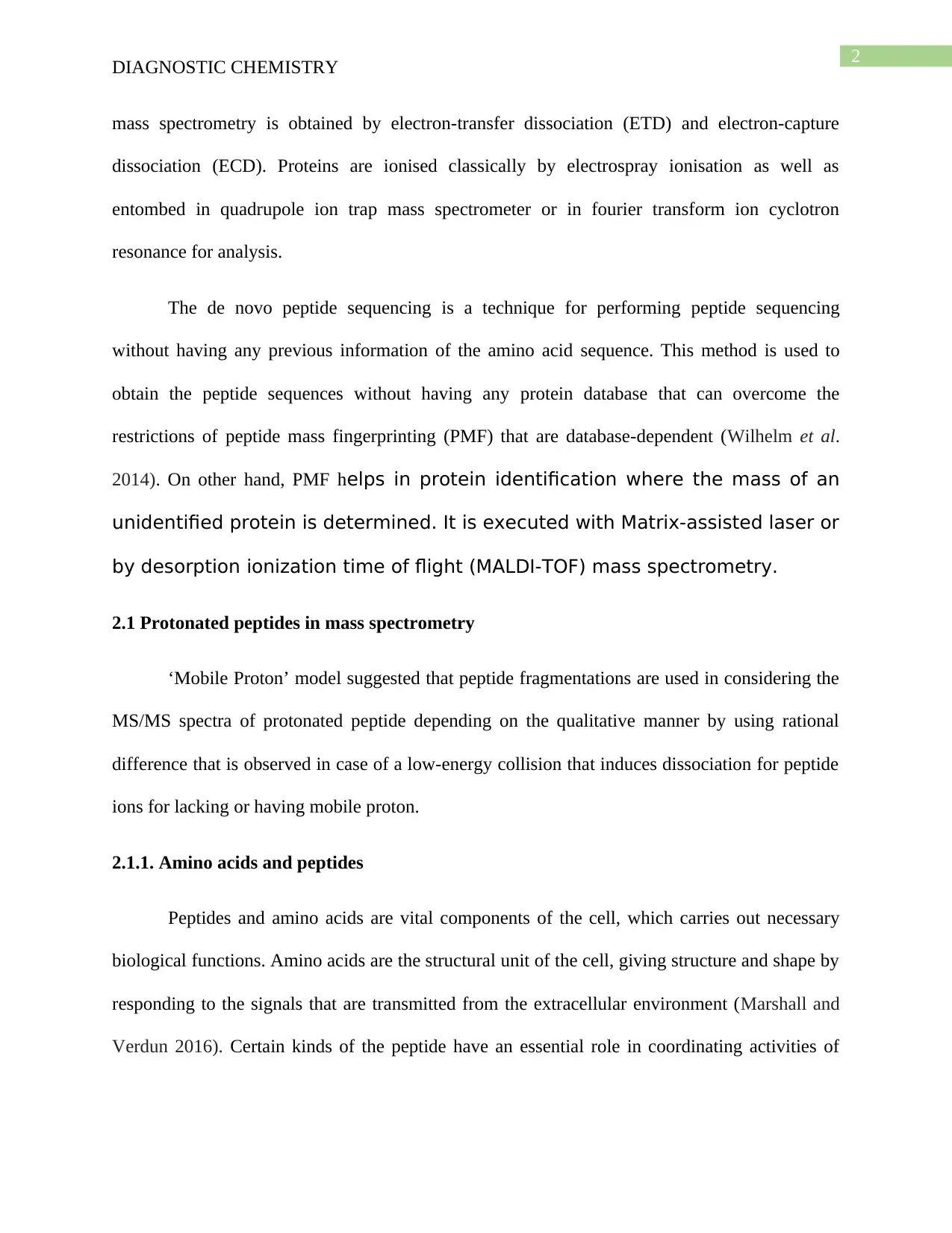
2
DIAGNOSTIC CHEMISTRY
mass spectrometry is obtained by electron-transfer dissociation (ETD) and electron-capture
dissociation (ECD). Proteins are ionised classically by electrospray ionisation as well as
entombed in quadrupole ion trap mass spectrometer or in fourier transform ion cyclotron
resonance for analysis.
The de novo peptide sequencing is a technique for performing peptide sequencing
without having any previous information of the amino acid sequence. This method is used to
obtain the peptide sequences without having any protein database that can overcome the
restrictions of peptide mass fingerprinting (PMF) that are database-dependent (Wilhelm et al.
2014). On other hand, PMF helps in protein identification where the mass of an
unidentified protein is determined. It is executed with Matrix-assisted laser or
by desorption ionization time of flight (MALDI-TOF) mass spectrometry.
2.1 Protonated peptides in mass spectrometry
‘Mobile Proton’ model suggested that peptide fragmentations are used in considering the
MS/MS spectra of protonated peptide depending on the qualitative manner by using rational
difference that is observed in case of a low-energy collision that induces dissociation for peptide
ions for lacking or having mobile proton.
2.1.1. Amino acids and peptides
Peptides and amino acids are vital components of the cell, which carries out necessary
biological functions. Amino acids are the structural unit of the cell, giving structure and shape by
responding to the signals that are transmitted from the extracellular environment (Marshall and
Verdun 2016). Certain kinds of the peptide have an essential role in coordinating activities of
DIAGNOSTIC CHEMISTRY
mass spectrometry is obtained by electron-transfer dissociation (ETD) and electron-capture
dissociation (ECD). Proteins are ionised classically by electrospray ionisation as well as
entombed in quadrupole ion trap mass spectrometer or in fourier transform ion cyclotron
resonance for analysis.
The de novo peptide sequencing is a technique for performing peptide sequencing
without having any previous information of the amino acid sequence. This method is used to
obtain the peptide sequences without having any protein database that can overcome the
restrictions of peptide mass fingerprinting (PMF) that are database-dependent (Wilhelm et al.
2014). On other hand, PMF helps in protein identification where the mass of an
unidentified protein is determined. It is executed with Matrix-assisted laser or
by desorption ionization time of flight (MALDI-TOF) mass spectrometry.
2.1 Protonated peptides in mass spectrometry
‘Mobile Proton’ model suggested that peptide fragmentations are used in considering the
MS/MS spectra of protonated peptide depending on the qualitative manner by using rational
difference that is observed in case of a low-energy collision that induces dissociation for peptide
ions for lacking or having mobile proton.
2.1.1. Amino acids and peptides
Peptides and amino acids are vital components of the cell, which carries out necessary
biological functions. Amino acids are the structural unit of the cell, giving structure and shape by
responding to the signals that are transmitted from the extracellular environment (Marshall and
Verdun 2016). Certain kinds of the peptide have an essential role in coordinating activities of
⊘ This is a preview!⊘
Do you want full access?
Subscribe today to unlock all pages.

Trusted by 1+ million students worldwide
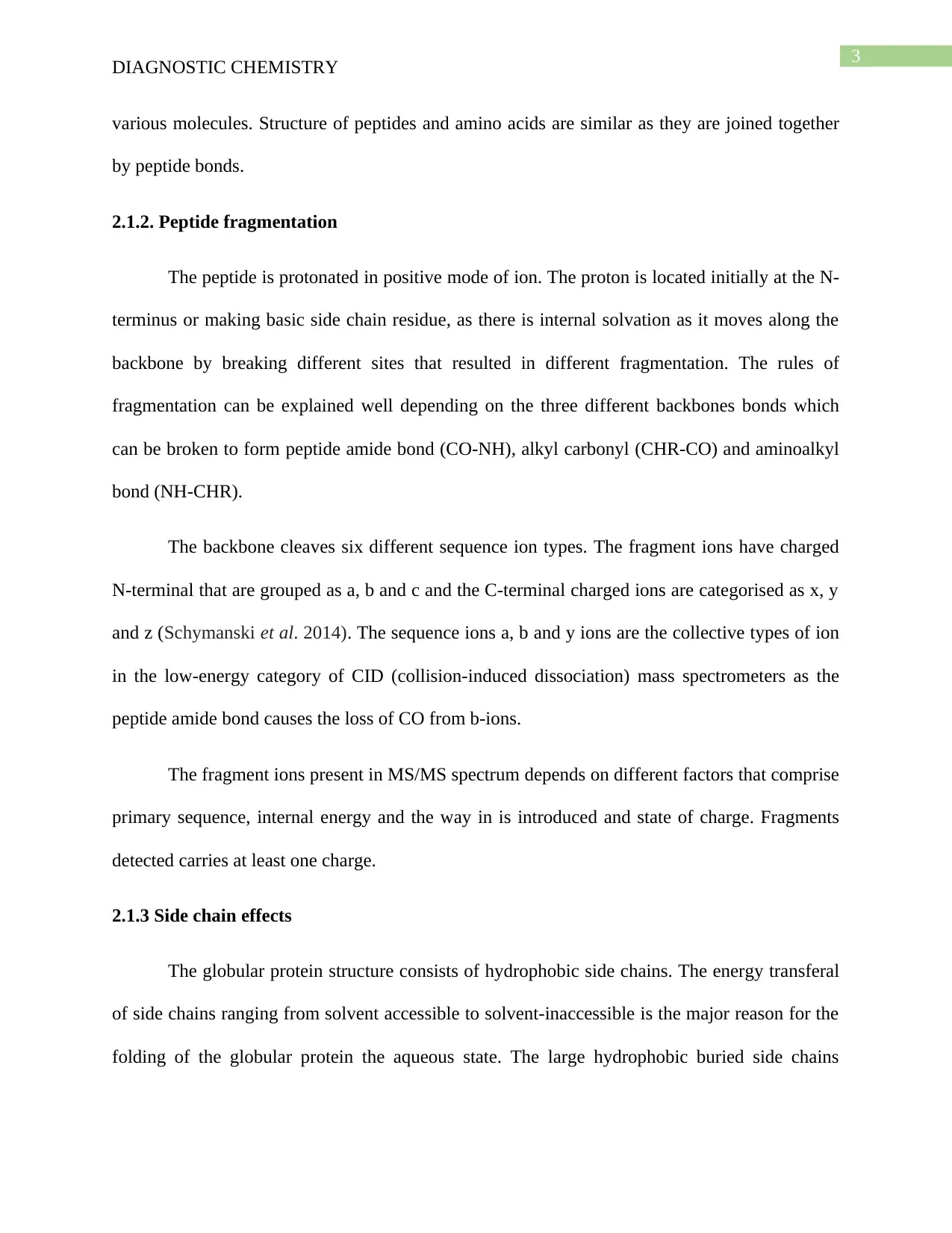
3
DIAGNOSTIC CHEMISTRY
various molecules. Structure of peptides and amino acids are similar as they are joined together
by peptide bonds.
2.1.2. Peptide fragmentation
The peptide is protonated in positive mode of ion. The proton is located initially at the N-
terminus or making basic side chain residue, as there is internal solvation as it moves along the
backbone by breaking different sites that resulted in different fragmentation. The rules of
fragmentation can be explained well depending on the three different backbones bonds which
can be broken to form peptide amide bond (CO-NH), alkyl carbonyl (CHR-CO) and aminoalkyl
bond (NH-CHR).
The backbone cleaves six different sequence ion types. The fragment ions have charged
N-terminal that are grouped as a, b and c and the C-terminal charged ions are categorised as x, y
and z (Schymanski et al. 2014). The sequence ions a, b and y ions are the collective types of ion
in the low-energy category of CID (collision-induced dissociation) mass spectrometers as the
peptide amide bond causes the loss of CO from b-ions.
The fragment ions present in MS/MS spectrum depends on different factors that comprise
primary sequence, internal energy and the way in is introduced and state of charge. Fragments
detected carries at least one charge.
2.1.3 Side chain effects
The globular protein structure consists of hydrophobic side chains. The energy transferal
of side chains ranging from solvent accessible to solvent-inaccessible is the major reason for the
folding of the globular protein the aqueous state. The large hydrophobic buried side chains
DIAGNOSTIC CHEMISTRY
various molecules. Structure of peptides and amino acids are similar as they are joined together
by peptide bonds.
2.1.2. Peptide fragmentation
The peptide is protonated in positive mode of ion. The proton is located initially at the N-
terminus or making basic side chain residue, as there is internal solvation as it moves along the
backbone by breaking different sites that resulted in different fragmentation. The rules of
fragmentation can be explained well depending on the three different backbones bonds which
can be broken to form peptide amide bond (CO-NH), alkyl carbonyl (CHR-CO) and aminoalkyl
bond (NH-CHR).
The backbone cleaves six different sequence ion types. The fragment ions have charged
N-terminal that are grouped as a, b and c and the C-terminal charged ions are categorised as x, y
and z (Schymanski et al. 2014). The sequence ions a, b and y ions are the collective types of ion
in the low-energy category of CID (collision-induced dissociation) mass spectrometers as the
peptide amide bond causes the loss of CO from b-ions.
The fragment ions present in MS/MS spectrum depends on different factors that comprise
primary sequence, internal energy and the way in is introduced and state of charge. Fragments
detected carries at least one charge.
2.1.3 Side chain effects
The globular protein structure consists of hydrophobic side chains. The energy transferal
of side chains ranging from solvent accessible to solvent-inaccessible is the major reason for the
folding of the globular protein the aqueous state. The large hydrophobic buried side chains
Paraphrase This Document
Need a fresh take? Get an instant paraphrase of this document with our AI Paraphraser
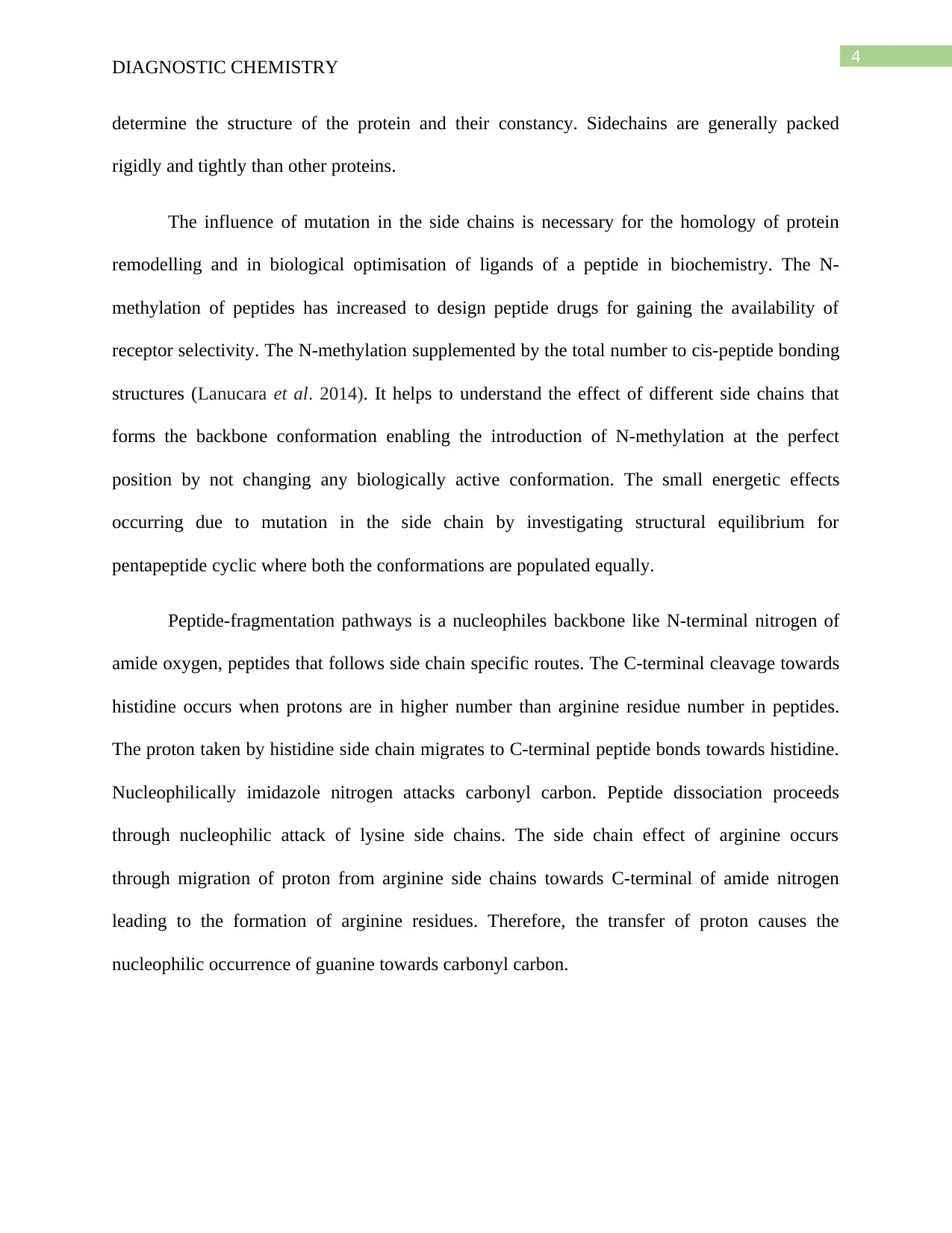
4
DIAGNOSTIC CHEMISTRY
determine the structure of the protein and their constancy. Sidechains are generally packed
rigidly and tightly than other proteins.
The influence of mutation in the side chains is necessary for the homology of protein
remodelling and in biological optimisation of ligands of a peptide in biochemistry. The N-
methylation of peptides has increased to design peptide drugs for gaining the availability of
receptor selectivity. The N-methylation supplemented by the total number to cis-peptide bonding
structures (Lanucara et al. 2014). It helps to understand the effect of different side chains that
forms the backbone conformation enabling the introduction of N-methylation at the perfect
position by not changing any biologically active conformation. The small energetic effects
occurring due to mutation in the side chain by investigating structural equilibrium for
pentapeptide cyclic where both the conformations are populated equally.
Peptide-fragmentation pathways is a nucleophiles backbone like N-terminal nitrogen of
amide oxygen, peptides that follows side chain specific routes. The C-terminal cleavage towards
histidine occurs when protons are in higher number than arginine residue number in peptides.
The proton taken by histidine side chain migrates to C-terminal peptide bonds towards histidine.
Nucleophilically imidazole nitrogen attacks carbonyl carbon. Peptide dissociation proceeds
through nucleophilic attack of lysine side chains. The side chain effect of arginine occurs
through migration of proton from arginine side chains towards C-terminal of amide nitrogen
leading to the formation of arginine residues. Therefore, the transfer of proton causes the
nucleophilic occurrence of guanine towards carbonyl carbon.
DIAGNOSTIC CHEMISTRY
determine the structure of the protein and their constancy. Sidechains are generally packed
rigidly and tightly than other proteins.
The influence of mutation in the side chains is necessary for the homology of protein
remodelling and in biological optimisation of ligands of a peptide in biochemistry. The N-
methylation of peptides has increased to design peptide drugs for gaining the availability of
receptor selectivity. The N-methylation supplemented by the total number to cis-peptide bonding
structures (Lanucara et al. 2014). It helps to understand the effect of different side chains that
forms the backbone conformation enabling the introduction of N-methylation at the perfect
position by not changing any biologically active conformation. The small energetic effects
occurring due to mutation in the side chain by investigating structural equilibrium for
pentapeptide cyclic where both the conformations are populated equally.
Peptide-fragmentation pathways is a nucleophiles backbone like N-terminal nitrogen of
amide oxygen, peptides that follows side chain specific routes. The C-terminal cleavage towards
histidine occurs when protons are in higher number than arginine residue number in peptides.
The proton taken by histidine side chain migrates to C-terminal peptide bonds towards histidine.
Nucleophilically imidazole nitrogen attacks carbonyl carbon. Peptide dissociation proceeds
through nucleophilic attack of lysine side chains. The side chain effect of arginine occurs
through migration of proton from arginine side chains towards C-terminal of amide nitrogen
leading to the formation of arginine residues. Therefore, the transfer of proton causes the
nucleophilic occurrence of guanine towards carbonyl carbon.
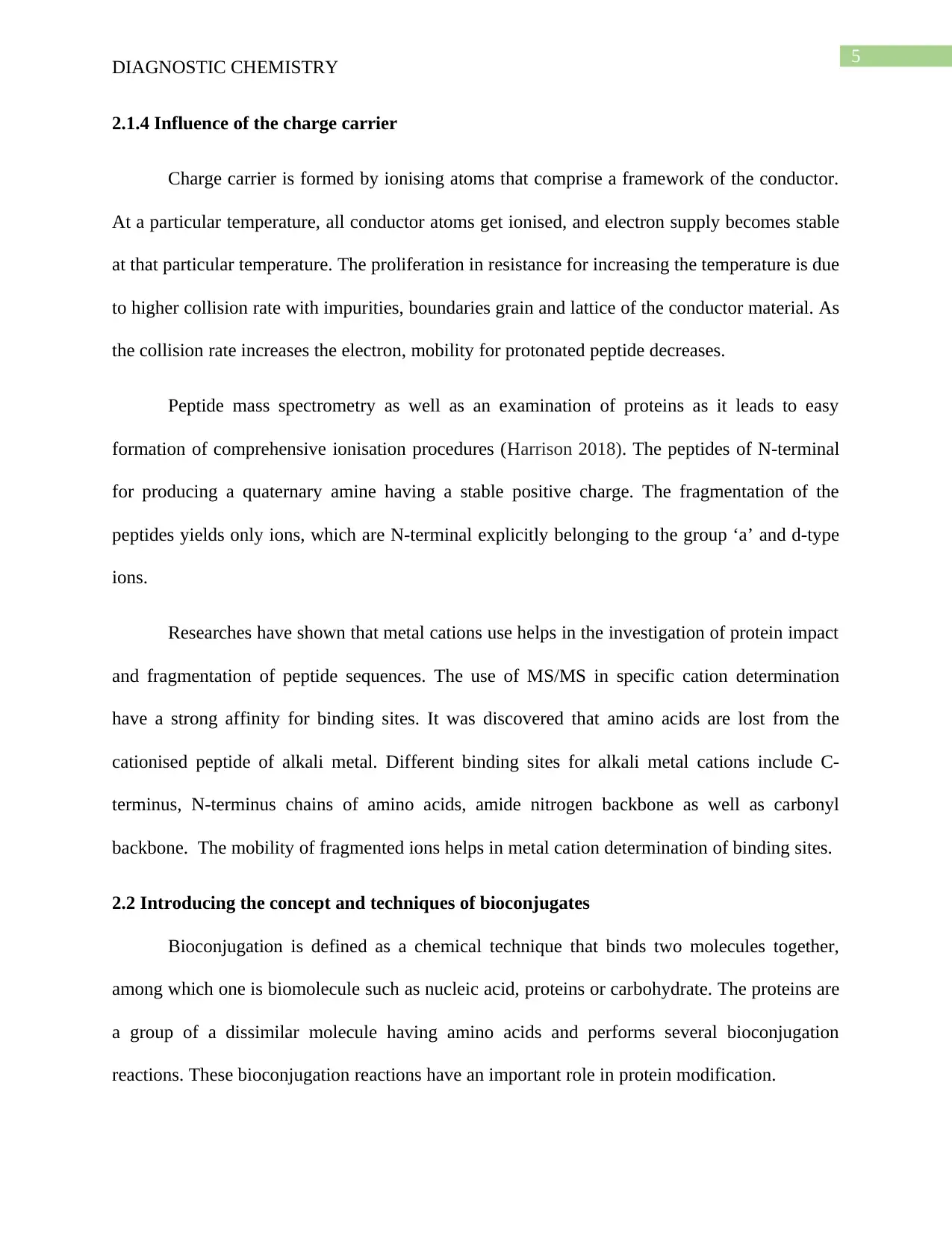
5
DIAGNOSTIC CHEMISTRY
2.1.4 Influence of the charge carrier
Charge carrier is formed by ionising atoms that comprise a framework of the conductor.
At a particular temperature, all conductor atoms get ionised, and electron supply becomes stable
at that particular temperature. The proliferation in resistance for increasing the temperature is due
to higher collision rate with impurities, boundaries grain and lattice of the conductor material. As
the collision rate increases the electron, mobility for protonated peptide decreases.
Peptide mass spectrometry as well as an examination of proteins as it leads to easy
formation of comprehensive ionisation procedures (Harrison 2018). The peptides of N-terminal
for producing a quaternary amine having a stable positive charge. The fragmentation of the
peptides yields only ions, which are N-terminal explicitly belonging to the group ‘a’ and d-type
ions.
Researches have shown that metal cations use helps in the investigation of protein impact
and fragmentation of peptide sequences. The use of MS/MS in specific cation determination
have a strong affinity for binding sites. It was discovered that amino acids are lost from the
cationised peptide of alkali metal. Different binding sites for alkali metal cations include C-
terminus, N-terminus chains of amino acids, amide nitrogen backbone as well as carbonyl
backbone. The mobility of fragmented ions helps in metal cation determination of binding sites.
2.2 Introducing the concept and techniques of bioconjugates
Bioconjugation is defined as a chemical technique that binds two molecules together,
among which one is biomolecule such as nucleic acid, proteins or carbohydrate. The proteins are
a group of a dissimilar molecule having amino acids and performs several bioconjugation
reactions. These bioconjugation reactions have an important role in protein modification.
DIAGNOSTIC CHEMISTRY
2.1.4 Influence of the charge carrier
Charge carrier is formed by ionising atoms that comprise a framework of the conductor.
At a particular temperature, all conductor atoms get ionised, and electron supply becomes stable
at that particular temperature. The proliferation in resistance for increasing the temperature is due
to higher collision rate with impurities, boundaries grain and lattice of the conductor material. As
the collision rate increases the electron, mobility for protonated peptide decreases.
Peptide mass spectrometry as well as an examination of proteins as it leads to easy
formation of comprehensive ionisation procedures (Harrison 2018). The peptides of N-terminal
for producing a quaternary amine having a stable positive charge. The fragmentation of the
peptides yields only ions, which are N-terminal explicitly belonging to the group ‘a’ and d-type
ions.
Researches have shown that metal cations use helps in the investigation of protein impact
and fragmentation of peptide sequences. The use of MS/MS in specific cation determination
have a strong affinity for binding sites. It was discovered that amino acids are lost from the
cationised peptide of alkali metal. Different binding sites for alkali metal cations include C-
terminus, N-terminus chains of amino acids, amide nitrogen backbone as well as carbonyl
backbone. The mobility of fragmented ions helps in metal cation determination of binding sites.
2.2 Introducing the concept and techniques of bioconjugates
Bioconjugation is defined as a chemical technique that binds two molecules together,
among which one is biomolecule such as nucleic acid, proteins or carbohydrate. The proteins are
a group of a dissimilar molecule having amino acids and performs several bioconjugation
reactions. These bioconjugation reactions have an important role in protein modification.
⊘ This is a preview!⊘
Do you want full access?
Subscribe today to unlock all pages.

Trusted by 1+ million students worldwide
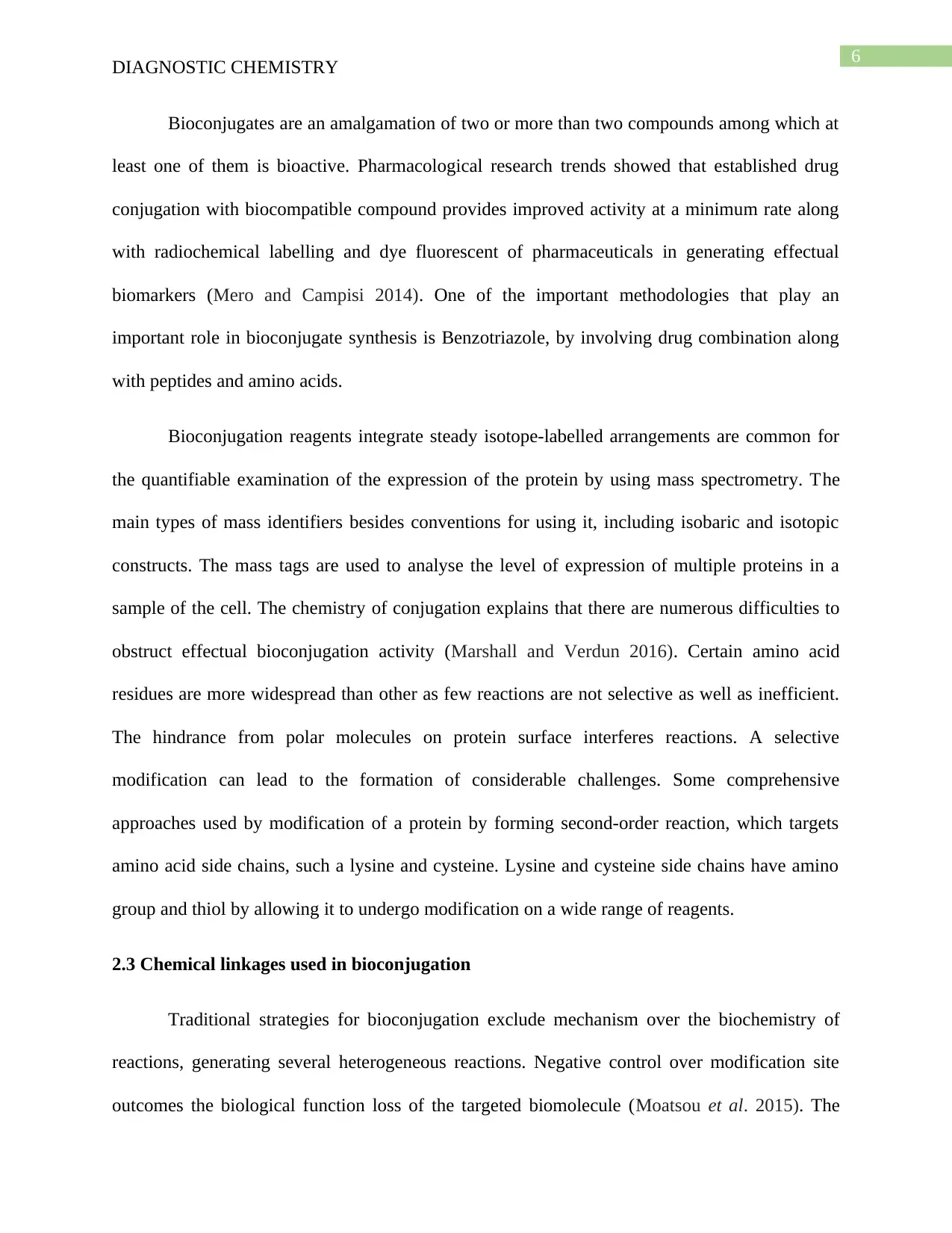
6
DIAGNOSTIC CHEMISTRY
Bioconjugates are an amalgamation of two or more than two compounds among which at
least one of them is bioactive. Pharmacological research trends showed that established drug
conjugation with biocompatible compound provides improved activity at a minimum rate along
with radiochemical labelling and dye fluorescent of pharmaceuticals in generating effectual
biomarkers (Mero and Campisi 2014). One of the important methodologies that play an
important role in bioconjugate synthesis is Benzotriazole, by involving drug combination along
with peptides and amino acids.
Bioconjugation reagents integrate steady isotope-labelled arrangements are common for
the quantifiable examination of the expression of the protein by using mass spectrometry. The
main types of mass identifiers besides conventions for using it, including isobaric and isotopic
constructs. The mass tags are used to analyse the level of expression of multiple proteins in a
sample of the cell. The chemistry of conjugation explains that there are numerous difficulties to
obstruct effectual bioconjugation activity (Marshall and Verdun 2016). Certain amino acid
residues are more widespread than other as few reactions are not selective as well as inefficient.
The hindrance from polar molecules on protein surface interferes reactions. A selective
modification can lead to the formation of considerable challenges. Some comprehensive
approaches used by modification of a protein by forming second-order reaction, which targets
amino acid side chains, such a lysine and cysteine. Lysine and cysteine side chains have amino
group and thiol by allowing it to undergo modification on a wide range of reagents.
2.3 Chemical linkages used in bioconjugation
Traditional strategies for bioconjugation exclude mechanism over the biochemistry of
reactions, generating several heterogeneous reactions. Negative control over modification site
outcomes the biological function loss of the targeted biomolecule (Moatsou et al. 2015). The
DIAGNOSTIC CHEMISTRY
Bioconjugates are an amalgamation of two or more than two compounds among which at
least one of them is bioactive. Pharmacological research trends showed that established drug
conjugation with biocompatible compound provides improved activity at a minimum rate along
with radiochemical labelling and dye fluorescent of pharmaceuticals in generating effectual
biomarkers (Mero and Campisi 2014). One of the important methodologies that play an
important role in bioconjugate synthesis is Benzotriazole, by involving drug combination along
with peptides and amino acids.
Bioconjugation reagents integrate steady isotope-labelled arrangements are common for
the quantifiable examination of the expression of the protein by using mass spectrometry. The
main types of mass identifiers besides conventions for using it, including isobaric and isotopic
constructs. The mass tags are used to analyse the level of expression of multiple proteins in a
sample of the cell. The chemistry of conjugation explains that there are numerous difficulties to
obstruct effectual bioconjugation activity (Marshall and Verdun 2016). Certain amino acid
residues are more widespread than other as few reactions are not selective as well as inefficient.
The hindrance from polar molecules on protein surface interferes reactions. A selective
modification can lead to the formation of considerable challenges. Some comprehensive
approaches used by modification of a protein by forming second-order reaction, which targets
amino acid side chains, such a lysine and cysteine. Lysine and cysteine side chains have amino
group and thiol by allowing it to undergo modification on a wide range of reagents.
2.3 Chemical linkages used in bioconjugation
Traditional strategies for bioconjugation exclude mechanism over the biochemistry of
reactions, generating several heterogeneous reactions. Negative control over modification site
outcomes the biological function loss of the targeted biomolecule (Moatsou et al. 2015). The
Paraphrase This Document
Need a fresh take? Get an instant paraphrase of this document with our AI Paraphraser
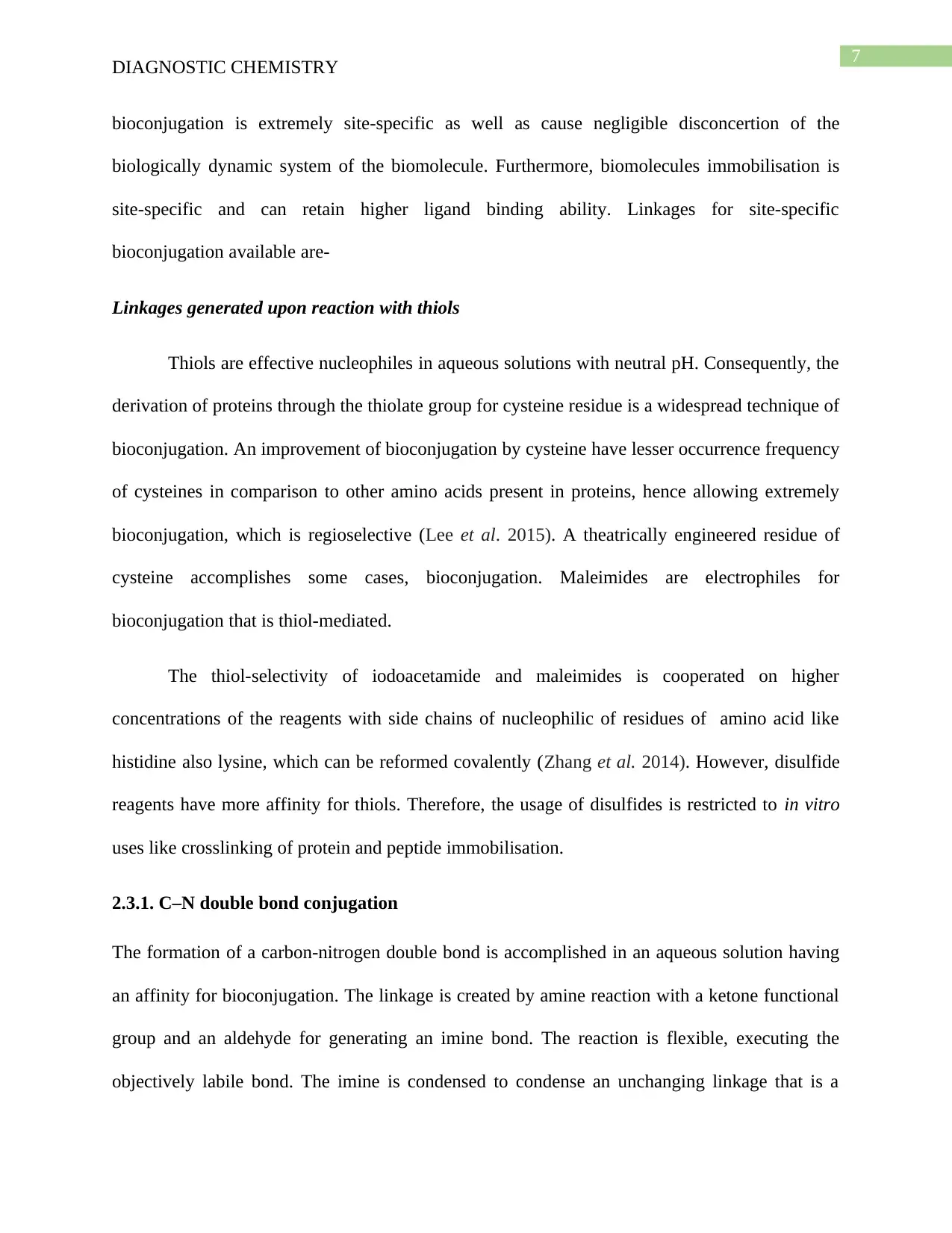
7
DIAGNOSTIC CHEMISTRY
bioconjugation is extremely site-specific as well as cause negligible disconcertion of the
biologically dynamic system of the biomolecule. Furthermore, biomolecules immobilisation is
site-specific and can retain higher ligand binding ability. Linkages for site-specific
bioconjugation available are-
Linkages generated upon reaction with thiols
Thiols are effective nucleophiles in aqueous solutions with neutral pH. Consequently, the
derivation of proteins through the thiolate group for cysteine residue is a widespread technique of
bioconjugation. An improvement of bioconjugation by cysteine have lesser occurrence frequency
of cysteines in comparison to other amino acids present in proteins, hence allowing extremely
bioconjugation, which is regioselective (Lee et al. 2015). A theatrically engineered residue of
cysteine accomplishes some cases, bioconjugation. Maleimides are electrophiles for
bioconjugation that is thiol-mediated.
The thiol-selectivity of iodoacetamide and maleimides is cooperated on higher
concentrations of the reagents with side chains of nucleophilic of residues of amino acid like
histidine also lysine, which can be reformed covalently (Zhang et al. 2014). However, disulfide
reagents have more affinity for thiols. Therefore, the usage of disulfides is restricted to in vitro
uses like crosslinking of protein and peptide immobilisation.
2.3.1. C–N double bond conjugation
The formation of a carbon-nitrogen double bond is accomplished in an aqueous solution having
an affinity for bioconjugation. The linkage is created by amine reaction with a ketone functional
group and an aldehyde for generating an imine bond. The reaction is flexible, executing the
objectively labile bond. The imine is condensed to condense an unchanging linkage that is a
DIAGNOSTIC CHEMISTRY
bioconjugation is extremely site-specific as well as cause negligible disconcertion of the
biologically dynamic system of the biomolecule. Furthermore, biomolecules immobilisation is
site-specific and can retain higher ligand binding ability. Linkages for site-specific
bioconjugation available are-
Linkages generated upon reaction with thiols
Thiols are effective nucleophiles in aqueous solutions with neutral pH. Consequently, the
derivation of proteins through the thiolate group for cysteine residue is a widespread technique of
bioconjugation. An improvement of bioconjugation by cysteine have lesser occurrence frequency
of cysteines in comparison to other amino acids present in proteins, hence allowing extremely
bioconjugation, which is regioselective (Lee et al. 2015). A theatrically engineered residue of
cysteine accomplishes some cases, bioconjugation. Maleimides are electrophiles for
bioconjugation that is thiol-mediated.
The thiol-selectivity of iodoacetamide and maleimides is cooperated on higher
concentrations of the reagents with side chains of nucleophilic of residues of amino acid like
histidine also lysine, which can be reformed covalently (Zhang et al. 2014). However, disulfide
reagents have more affinity for thiols. Therefore, the usage of disulfides is restricted to in vitro
uses like crosslinking of protein and peptide immobilisation.
2.3.1. C–N double bond conjugation
The formation of a carbon-nitrogen double bond is accomplished in an aqueous solution having
an affinity for bioconjugation. The linkage is created by amine reaction with a ketone functional
group and an aldehyde for generating an imine bond. The reaction is flexible, executing the
objectively labile bond. The imine is condensed to condense an unchanging linkage that is a
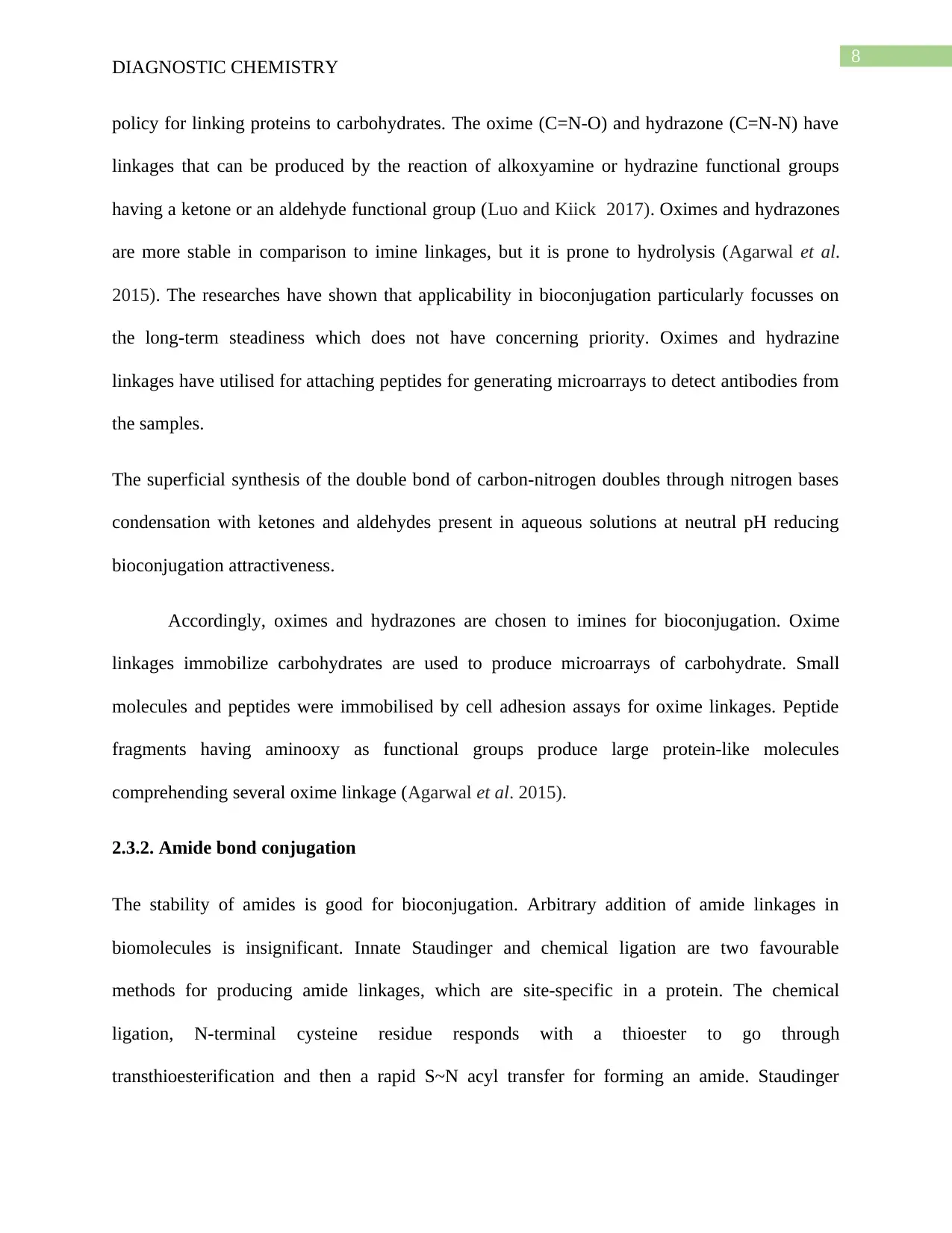
8
DIAGNOSTIC CHEMISTRY
policy for linking proteins to carbohydrates. The oxime (C=N-O) and hydrazone (C=N-N) have
linkages that can be produced by the reaction of alkoxyamine or hydrazine functional groups
having a ketone or an aldehyde functional group (Luo and Kiick 2017). Oximes and hydrazones
are more stable in comparison to imine linkages, but it is prone to hydrolysis (Agarwal et al.
2015). The researches have shown that applicability in bioconjugation particularly focusses on
the long-term steadiness which does not have concerning priority. Oximes and hydrazine
linkages have utilised for attaching peptides for generating microarrays to detect antibodies from
the samples.
The superficial synthesis of the double bond of carbon-nitrogen doubles through nitrogen bases
condensation with ketones and aldehydes present in aqueous solutions at neutral pH reducing
bioconjugation attractiveness.
Accordingly, oximes and hydrazones are chosen to imines for bioconjugation. Oxime
linkages immobilize carbohydrates are used to produce microarrays of carbohydrate. Small
molecules and peptides were immobilised by cell adhesion assays for oxime linkages. Peptide
fragments having aminooxy as functional groups produce large protein-like molecules
comprehending several oxime linkage (Agarwal et al. 2015).
2.3.2. Amide bond conjugation
The stability of amides is good for bioconjugation. Arbitrary addition of amide linkages in
biomolecules is insignificant. Innate Staudinger and chemical ligation are two favourable
methods for producing amide linkages, which are site-specific in a protein. The chemical
ligation, N-terminal cysteine residue responds with a thioester to go through
transthioesterification and then a rapid S~N acyl transfer for forming an amide. Staudinger
DIAGNOSTIC CHEMISTRY
policy for linking proteins to carbohydrates. The oxime (C=N-O) and hydrazone (C=N-N) have
linkages that can be produced by the reaction of alkoxyamine or hydrazine functional groups
having a ketone or an aldehyde functional group (Luo and Kiick 2017). Oximes and hydrazones
are more stable in comparison to imine linkages, but it is prone to hydrolysis (Agarwal et al.
2015). The researches have shown that applicability in bioconjugation particularly focusses on
the long-term steadiness which does not have concerning priority. Oximes and hydrazine
linkages have utilised for attaching peptides for generating microarrays to detect antibodies from
the samples.
The superficial synthesis of the double bond of carbon-nitrogen doubles through nitrogen bases
condensation with ketones and aldehydes present in aqueous solutions at neutral pH reducing
bioconjugation attractiveness.
Accordingly, oximes and hydrazones are chosen to imines for bioconjugation. Oxime
linkages immobilize carbohydrates are used to produce microarrays of carbohydrate. Small
molecules and peptides were immobilised by cell adhesion assays for oxime linkages. Peptide
fragments having aminooxy as functional groups produce large protein-like molecules
comprehending several oxime linkage (Agarwal et al. 2015).
2.3.2. Amide bond conjugation
The stability of amides is good for bioconjugation. Arbitrary addition of amide linkages in
biomolecules is insignificant. Innate Staudinger and chemical ligation are two favourable
methods for producing amide linkages, which are site-specific in a protein. The chemical
ligation, N-terminal cysteine residue responds with a thioester to go through
transthioesterification and then a rapid S~N acyl transfer for forming an amide. Staudinger
⊘ This is a preview!⊘
Do you want full access?
Subscribe today to unlock all pages.

Trusted by 1+ million students worldwide
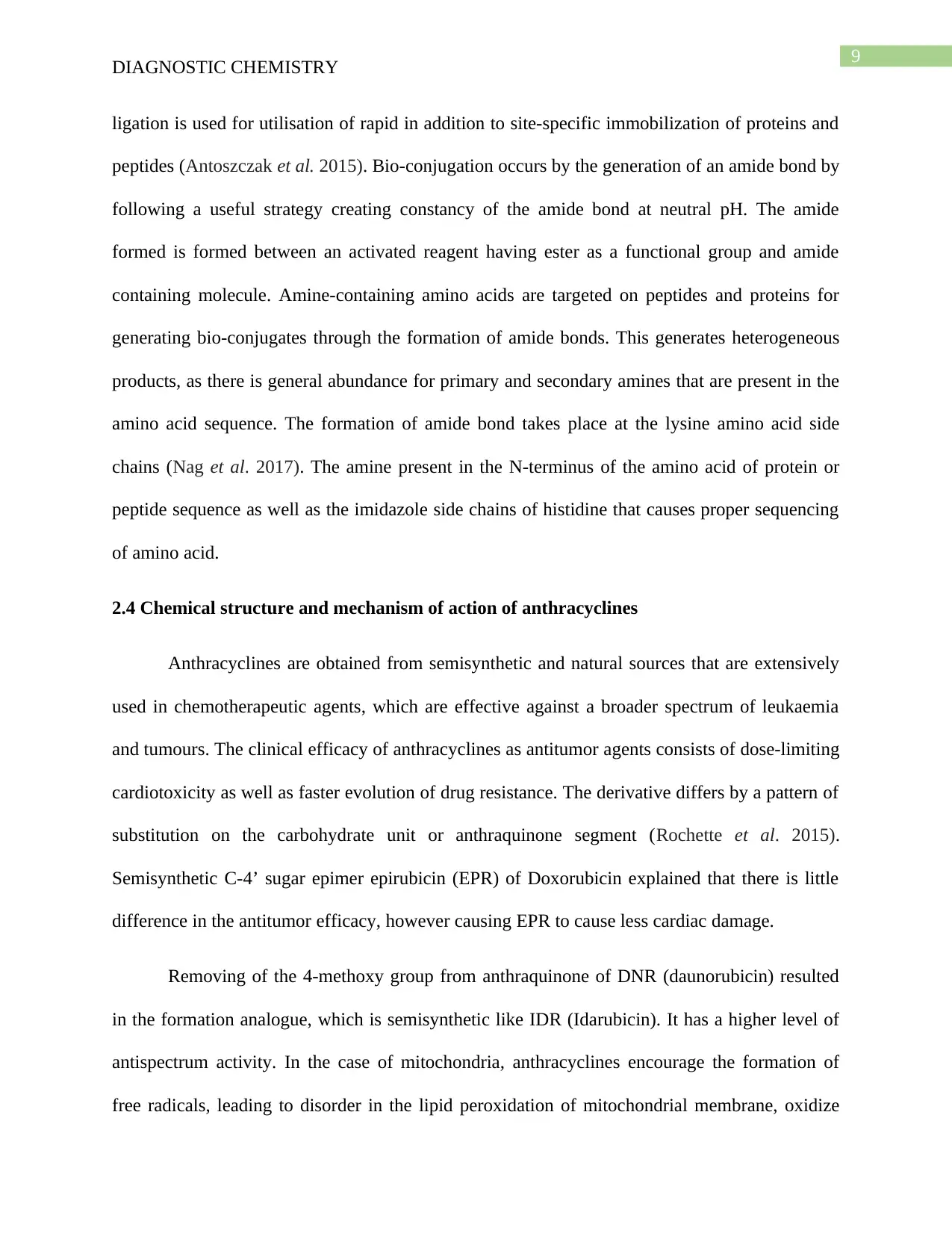
9
DIAGNOSTIC CHEMISTRY
ligation is used for utilisation of rapid in addition to site-specific immobilization of proteins and
peptides (Antoszczak et al. 2015). Bio-conjugation occurs by the generation of an amide bond by
following a useful strategy creating constancy of the amide bond at neutral pH. The amide
formed is formed between an activated reagent having ester as a functional group and amide
containing molecule. Amine-containing amino acids are targeted on peptides and proteins for
generating bio-conjugates through the formation of amide bonds. This generates heterogeneous
products, as there is general abundance for primary and secondary amines that are present in the
amino acid sequence. The formation of amide bond takes place at the lysine amino acid side
chains (Nag et al. 2017). The amine present in the N-terminus of the amino acid of protein or
peptide sequence as well as the imidazole side chains of histidine that causes proper sequencing
of amino acid.
2.4 Chemical structure and mechanism of action of anthracyclines
Anthracyclines are obtained from semisynthetic and natural sources that are extensively
used in chemotherapeutic agents, which are effective against a broader spectrum of leukaemia
and tumours. The clinical efficacy of anthracyclines as antitumor agents consists of dose-limiting
cardiotoxicity as well as faster evolution of drug resistance. The derivative differs by a pattern of
substitution on the carbohydrate unit or anthraquinone segment (Rochette et al. 2015).
Semisynthetic C-4’ sugar epimer epirubicin (EPR) of Doxorubicin explained that there is little
difference in the antitumor efficacy, however causing EPR to cause less cardiac damage.
Removing of the 4-methoxy group from anthraquinone of DNR (daunorubicin) resulted
in the formation analogue, which is semisynthetic like IDR (Idarubicin). It has a higher level of
antispectrum activity. In the case of mitochondria, anthracyclines encourage the formation of
free radicals, leading to disorder in the lipid peroxidation of mitochondrial membrane, oxidize
DIAGNOSTIC CHEMISTRY
ligation is used for utilisation of rapid in addition to site-specific immobilization of proteins and
peptides (Antoszczak et al. 2015). Bio-conjugation occurs by the generation of an amide bond by
following a useful strategy creating constancy of the amide bond at neutral pH. The amide
formed is formed between an activated reagent having ester as a functional group and amide
containing molecule. Amine-containing amino acids are targeted on peptides and proteins for
generating bio-conjugates through the formation of amide bonds. This generates heterogeneous
products, as there is general abundance for primary and secondary amines that are present in the
amino acid sequence. The formation of amide bond takes place at the lysine amino acid side
chains (Nag et al. 2017). The amine present in the N-terminus of the amino acid of protein or
peptide sequence as well as the imidazole side chains of histidine that causes proper sequencing
of amino acid.
2.4 Chemical structure and mechanism of action of anthracyclines
Anthracyclines are obtained from semisynthetic and natural sources that are extensively
used in chemotherapeutic agents, which are effective against a broader spectrum of leukaemia
and tumours. The clinical efficacy of anthracyclines as antitumor agents consists of dose-limiting
cardiotoxicity as well as faster evolution of drug resistance. The derivative differs by a pattern of
substitution on the carbohydrate unit or anthraquinone segment (Rochette et al. 2015).
Semisynthetic C-4’ sugar epimer epirubicin (EPR) of Doxorubicin explained that there is little
difference in the antitumor efficacy, however causing EPR to cause less cardiac damage.
Removing of the 4-methoxy group from anthraquinone of DNR (daunorubicin) resulted
in the formation analogue, which is semisynthetic like IDR (Idarubicin). It has a higher level of
antispectrum activity. In the case of mitochondria, anthracyclines encourage the formation of
free radicals, leading to disorder in the lipid peroxidation of mitochondrial membrane, oxidize
Paraphrase This Document
Need a fresh take? Get an instant paraphrase of this document with our AI Paraphraser
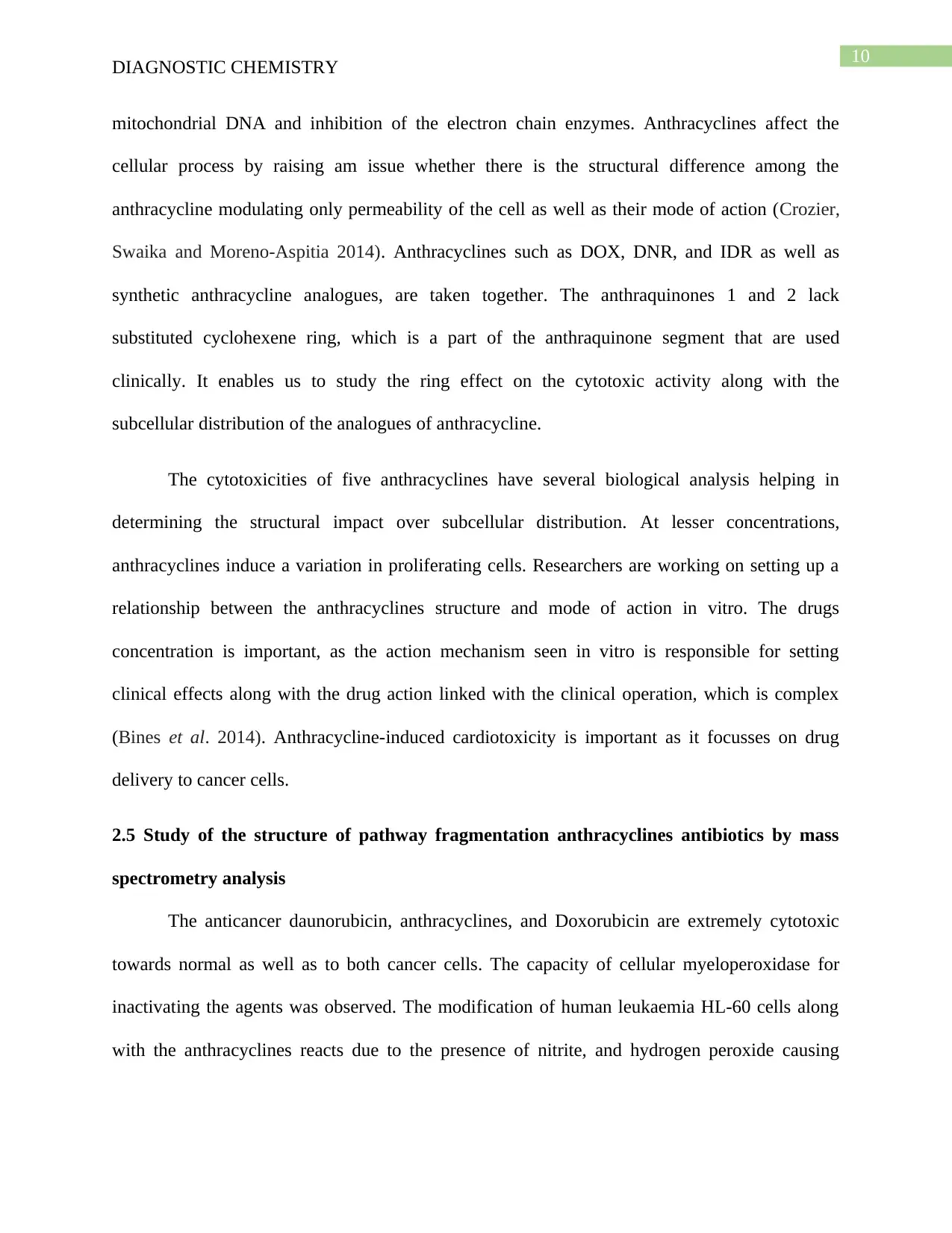
10
DIAGNOSTIC CHEMISTRY
mitochondrial DNA and inhibition of the electron chain enzymes. Anthracyclines affect the
cellular process by raising am issue whether there is the structural difference among the
anthracycline modulating only permeability of the cell as well as their mode of action (Crozier,
Swaika and Moreno-Aspitia 2014). Anthracyclines such as DOX, DNR, and IDR as well as
synthetic anthracycline analogues, are taken together. The anthraquinones 1 and 2 lack
substituted cyclohexene ring, which is a part of the anthraquinone segment that are used
clinically. It enables us to study the ring effect on the cytotoxic activity along with the
subcellular distribution of the analogues of anthracycline.
The cytotoxicities of five anthracyclines have several biological analysis helping in
determining the structural impact over subcellular distribution. At lesser concentrations,
anthracyclines induce a variation in proliferating cells. Researchers are working on setting up a
relationship between the anthracyclines structure and mode of action in vitro. The drugs
concentration is important, as the action mechanism seen in vitro is responsible for setting
clinical effects along with the drug action linked with the clinical operation, which is complex
(Bines et al. 2014). Anthracycline-induced cardiotoxicity is important as it focusses on drug
delivery to cancer cells.
2.5 Study of the structure of pathway fragmentation anthracyclines antibiotics by mass
spectrometry analysis
The anticancer daunorubicin, anthracyclines, and Doxorubicin are extremely cytotoxic
towards normal as well as to both cancer cells. The capacity of cellular myeloperoxidase for
inactivating the agents was observed. The modification of human leukaemia HL-60 cells along
with the anthracyclines reacts due to the presence of nitrite, and hydrogen peroxide causing
DIAGNOSTIC CHEMISTRY
mitochondrial DNA and inhibition of the electron chain enzymes. Anthracyclines affect the
cellular process by raising am issue whether there is the structural difference among the
anthracycline modulating only permeability of the cell as well as their mode of action (Crozier,
Swaika and Moreno-Aspitia 2014). Anthracyclines such as DOX, DNR, and IDR as well as
synthetic anthracycline analogues, are taken together. The anthraquinones 1 and 2 lack
substituted cyclohexene ring, which is a part of the anthraquinone segment that are used
clinically. It enables us to study the ring effect on the cytotoxic activity along with the
subcellular distribution of the analogues of anthracycline.
The cytotoxicities of five anthracyclines have several biological analysis helping in
determining the structural impact over subcellular distribution. At lesser concentrations,
anthracyclines induce a variation in proliferating cells. Researchers are working on setting up a
relationship between the anthracyclines structure and mode of action in vitro. The drugs
concentration is important, as the action mechanism seen in vitro is responsible for setting
clinical effects along with the drug action linked with the clinical operation, which is complex
(Bines et al. 2014). Anthracycline-induced cardiotoxicity is important as it focusses on drug
delivery to cancer cells.
2.5 Study of the structure of pathway fragmentation anthracyclines antibiotics by mass
spectrometry analysis
The anticancer daunorubicin, anthracyclines, and Doxorubicin are extremely cytotoxic
towards normal as well as to both cancer cells. The capacity of cellular myeloperoxidase for
inactivating the agents was observed. The modification of human leukaemia HL-60 cells along
with the anthracyclines reacts due to the presence of nitrite, and hydrogen peroxide causing
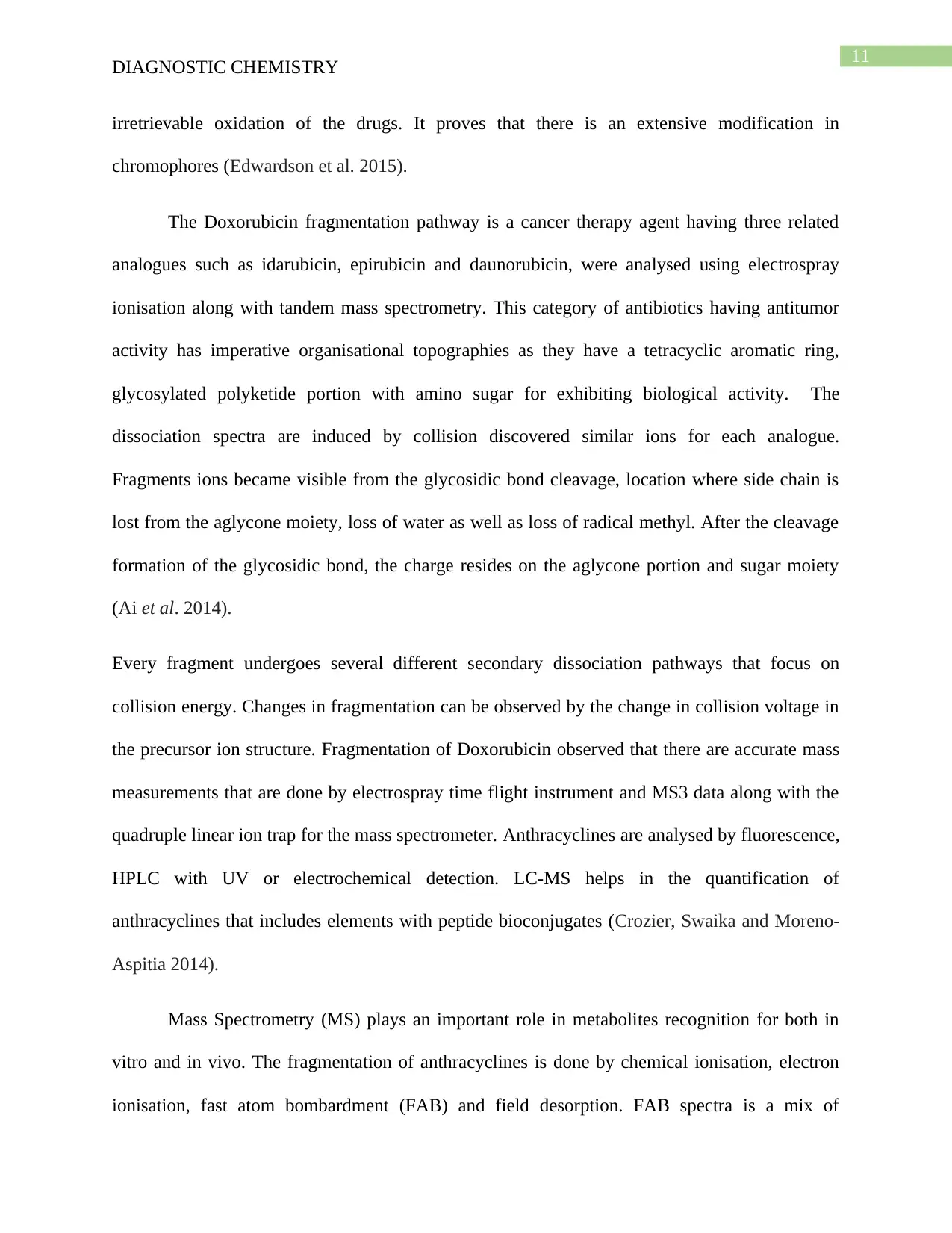
11
DIAGNOSTIC CHEMISTRY
irretrievable oxidation of the drugs. It proves that there is an extensive modification in
chromophores (Edwardson et al. 2015).
The Doxorubicin fragmentation pathway is a cancer therapy agent having three related
analogues such as idarubicin, epirubicin and daunorubicin, were analysed using electrospray
ionisation along with tandem mass spectrometry. This category of antibiotics having antitumor
activity has imperative organisational topographies as they have a tetracyclic aromatic ring,
glycosylated polyketide portion with amino sugar for exhibiting biological activity. The
dissociation spectra are induced by collision discovered similar ions for each analogue.
Fragments ions became visible from the glycosidic bond cleavage, location where side chain is
lost from the aglycone moiety, loss of water as well as loss of radical methyl. After the cleavage
formation of the glycosidic bond, the charge resides on the aglycone portion and sugar moiety
(Ai et al. 2014).
Every fragment undergoes several different secondary dissociation pathways that focus on
collision energy. Changes in fragmentation can be observed by the change in collision voltage in
the precursor ion structure. Fragmentation of Doxorubicin observed that there are accurate mass
measurements that are done by electrospray time flight instrument and MS3 data along with the
quadruple linear ion trap for the mass spectrometer. Anthracyclines are analysed by fluorescence,
HPLC with UV or electrochemical detection. LC-MS helps in the quantification of
anthracyclines that includes elements with peptide bioconjugates (Crozier, Swaika and Moreno-
Aspitia 2014).
Mass Spectrometry (MS) plays an important role in metabolites recognition for both in
vitro and in vivo. The fragmentation of anthracyclines is done by chemical ionisation, electron
ionisation, fast atom bombardment (FAB) and field desorption. FAB spectra is a mix of
DIAGNOSTIC CHEMISTRY
irretrievable oxidation of the drugs. It proves that there is an extensive modification in
chromophores (Edwardson et al. 2015).
The Doxorubicin fragmentation pathway is a cancer therapy agent having three related
analogues such as idarubicin, epirubicin and daunorubicin, were analysed using electrospray
ionisation along with tandem mass spectrometry. This category of antibiotics having antitumor
activity has imperative organisational topographies as they have a tetracyclic aromatic ring,
glycosylated polyketide portion with amino sugar for exhibiting biological activity. The
dissociation spectra are induced by collision discovered similar ions for each analogue.
Fragments ions became visible from the glycosidic bond cleavage, location where side chain is
lost from the aglycone moiety, loss of water as well as loss of radical methyl. After the cleavage
formation of the glycosidic bond, the charge resides on the aglycone portion and sugar moiety
(Ai et al. 2014).
Every fragment undergoes several different secondary dissociation pathways that focus on
collision energy. Changes in fragmentation can be observed by the change in collision voltage in
the precursor ion structure. Fragmentation of Doxorubicin observed that there are accurate mass
measurements that are done by electrospray time flight instrument and MS3 data along with the
quadruple linear ion trap for the mass spectrometer. Anthracyclines are analysed by fluorescence,
HPLC with UV or electrochemical detection. LC-MS helps in the quantification of
anthracyclines that includes elements with peptide bioconjugates (Crozier, Swaika and Moreno-
Aspitia 2014).
Mass Spectrometry (MS) plays an important role in metabolites recognition for both in
vitro and in vivo. The fragmentation of anthracyclines is done by chemical ionisation, electron
ionisation, fast atom bombardment (FAB) and field desorption. FAB spectra is a mix of
⊘ This is a preview!⊘
Do you want full access?
Subscribe today to unlock all pages.

Trusted by 1+ million students worldwide
1 out of 20
Your All-in-One AI-Powered Toolkit for Academic Success.
+13062052269
info@desklib.com
Available 24*7 on WhatsApp / Email
![[object Object]](/_next/static/media/star-bottom.7253800d.svg)
Unlock your academic potential
Copyright © 2020–2025 A2Z Services. All Rights Reserved. Developed and managed by ZUCOL.
